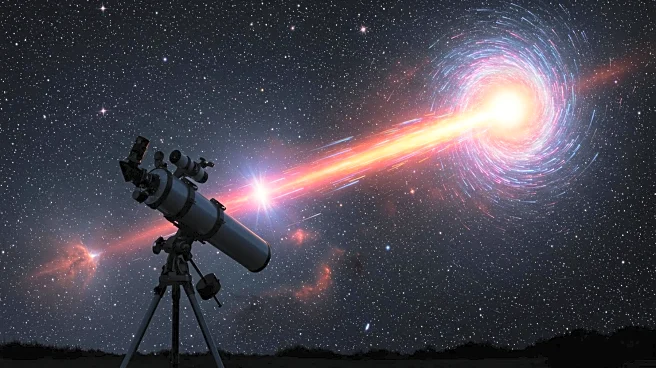What's Happening?
Physicists from the University of Copenhagen have embarked on an innovative experiment to detect axions, a theoretical particle believed to be a key component of dark matter. Utilizing the massive magnetic fields of galaxy clusters, the researchers observed electromagnetic radiation from supermassive black holes at the centers of distant galaxies. As this radiation traverses the magnetic fields, it may transform into axions, leaving subtle fluctuations in the data. By analyzing signals from 32 supermassive black holes, the team identified a pattern that could indicate the presence of axions. This approach, detailed in a paper published in Nature Astronomy, represents a significant step in the ongoing quest to understand dark matter, which constitutes approximately 80% of the universe's mass.
Why It's Important?
The potential discovery of axions would mark a monumental advancement in physics, offering insights into the nature of dark matter, a fundamental yet elusive component of the universe. This research could reshape our understanding of cosmic structures and the forces governing them. The method developed by the University of Copenhagen team not only enhances the search for axions but also provides a framework for future studies. If axions are confirmed, it could lead to breakthroughs in both theoretical physics and practical applications, potentially influencing fields such as astrophysics and cosmology. The findings could also stimulate further research and collaboration among international scientific communities.
What's Next?
The researchers plan to expand their study by applying their method to other types of electromagnetic radiation, such as X-rays, to further investigate the presence of axions. This approach could be adopted by other research groups, broadening the scope of the search across different masses and energies. Continued exploration in this area may eventually lead to definitive evidence of axions, thereby narrowing down the characteristics and behaviors of dark matter. The scientific community will likely monitor these developments closely, as they hold the potential to unlock new dimensions of understanding in particle physics and cosmology.
Beyond the Headlines
The implications of this research extend beyond the immediate scientific community, potentially influencing philosophical and existential discussions about the universe's composition and our place within it. The pursuit of understanding dark matter challenges existing paradigms and encourages a reevaluation of the fundamental laws of physics. Additionally, the innovative use of cosmic phenomena as a natural laboratory exemplifies the creative approaches scientists are employing to tackle some of the most profound questions in science.











